Tübingen
Tübingen (German: [ˈtyːbɪŋən], ![]()
Tübingen | |
|---|---|
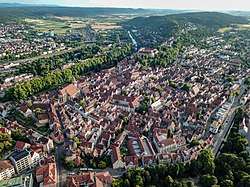 Tübingen seen from above in June 2018 | |
 Coat of arms | |
Location of Tübingen within Tübingen district  | |
 Tübingen  Tübingen | |
| Coordinates: 48°31′12″N 09°03′20″E | |
| Country | Germany |
| State | Baden-Württemberg |
| Admin. region | Tübingen |
| District | Tübingen |
| Government | |
| • Lord Mayor | Boris Palmer (Greens) |
| Area | |
| • Total | 108.12 km2 (41.75 sq mi) |
| Elevation | 341 m (1,119 ft) |
| Population (2018-12-31)[1] | |
| • Total | 90,546 |
| • Density | 840/km2 (2,200/sq mi) |
| Time zone | CET/CEST (UTC+1/+2) |
| Postal codes | 72001–72099 |
| Dialling codes | 07071 07073 (Unterjesingen) 07472 (Bühl) |
| Vehicle registration | TÜ |
| Website | www.tuebingen.de |
Immediately north of the city lies the Schönbuch, a densely wooded nature park. The Swabian Alb mountains rise about 13 km (8 mi) (beeline Tübingen City to Roßberg - 869 m) to the southeast of Tübingen.
The Ammer and Steinlach rivers are tributaries of the Neckar river, which flows in an easterly direction through the city, just south of the medieval old town. Large parts of the city are hilly, with the Schlossberg and the Österberg in the city centre and the Schnarrenberg and Herrlesberg, among others, rising immediately adjacent to the inner city.
The highest point is at about 500 m (1,640.42 ft) above sea level near Bebenhausen in the Schönbuch forest, while the lowest point is 305 m (1,000.66 ft) in the town's eastern Neckar valley. The geographical centre of the state of Baden-Württemberg is in a small forest called Elysium, near the Botanical Gardens of the city's university.
Regional structure
Tübingen is the capital of an eponymous district and an eponymous administrative region (Regierungsbezirk), before 1973 called Südwürttemberg-Hohenzollern.
Tübingen is, with nearby Reutlingen (about 15 km (9.3 mi) east), one of the two centre cities of the Neckar-Alb region.
Administratively, it is not part of the Stuttgart Region, bordering it to the north and west (Esslingen district in the north and Böblingen district in the west). However, the city and northern parts of its district can be regarded as belonging to that region in a wider regional and cultural context.
History
The area was probably first settled by ancient humans in the 12th millennium BC. The Romans left some traces here in AD 85, when they built a limes frontier wall at the Neckar River. Tübingen dates from the 6th or 7th century, when the region was populated by the Alamanni people. Some historians argue that the Battle of Solicinium was fought at Spitzberg, a mountain in Tübingen, in AD 367, although there is no evidence for this.
Tübingen first appears in official records in 1191. The local castle, Hohentübingen, has records going back to 1078, when it was besieged by Henry IV, king of Germany. Its name was transcribed in Medieval Latin as Tuingia and Twingia.
From 1146, Count Hugo V (1125–52) was promoted to count palatine as Hugo I. Tübingen was established as the capital of a County Palatine of Tübingen. By 1231, Tübingen was a civitas, indicating recognition by the Crown of civil liberties and a court system.
In 1262, an Augustinian monastery was established by Pope Alexander IV in Tübingen; in 1272, a Franciscan monastery was founded. In 1300, a Latin school (today's Uhland-Gymnasium) was founded. During the Protestant Reformation, which Duke Ulrich of Würtemmberg converted to, he disestablished the Franciscan monastery in 1535.
In 1342, the county palatine was sold to Ulrich III, Count of Württemberg and incorporated into the County of Württemberg.

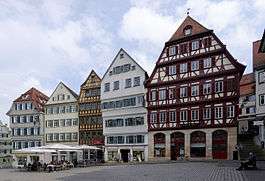
Between 1470 and 1483, St. George's Collegiate Church was built. The collegiate church offices provided the opportunity for what soon afterwards became the most significant event in Tübingen's history: the founding of the Eberhard Karls University by Duke Eberhard im Bart of Württemberg in 1477, thus making it one of the oldest universities in Central Europe. It became soon renowned as one of the most influential places of learning in the Holy Roman Empire, especially for theology (a Protestant faculty, Tübinger Stift, was established in 1535 in the former Augustinian monastery). Today, the university is still the biggest source of income for the residents of the city and one of the biggest universities in Germany with more than 26,000 students.
Between 1622 and 1625, the Catholic League occupied Lutheran Württemberg in the course of the Thirty Years' War. In the summer of 1631, the city was raided. In 1635/36 the city was hit by the Plague. In 1638, Swedish troops conquered Tübingen. Towards the end of the war, French troops occupied the city from 1647 until 1649.
In 1789, parts of the old town burned down, but were later rebuilt in the original style. In 1798 the Allgemeine Zeitung, a leading newspaper in early 19th-century Germany, was founded in Tübingen by Johann Friedrich Cotta. From 1807 until 1843, the poet Friedrich Hölderlin lived in Tübingen in a tower overlooking the Neckar.
In the Nazi era, the Tübingen Synagogue was burned in the Kristallnacht on November 9, 1938. The Second World War left the city largely unscathed, mainly because of the peace initiative of a local doctor, Theodor Dobler. It was occupied by the French army and became part of the French occupational zone. From 1946 to 1952, Tübingen was the capital of the newly formed state of Württemberg-Hohenzollern (as French: Tubingue), before the state of Baden-Württemberg was created by merging Baden, Württemberg-Baden and Württemberg-Hohenzollern. The French troops had a garrison stationed in the south of the city until the end of the Cold War in the 1990s.
In the 1960s, Tübingen was one of the centres of the German student movement and the Protests of 1968 and has ever since shaped left and green political views. Some radicalized Tübingen students supported the leftist Rote Armee Fraktion terrorist group, with active member Gudrun Ensslin, a local and a Tübingen student from 1960 to 1963, joining the group in 1968.
Although noticing such things today is largely impossible, as recently as the 1950s, Tübingen was a very socioeconomically divided city, with poor local farmers and tradesmen living along the Stadtgraben (City Canal) and students and academics residing around the Alte Aula and the Burse, the old university buildings. There, hanging on the Cottahaus, a sign commemorates Goethe's stay of a few weeks while visiting his publisher. The German tendency to memorialize every minor presence of its historical greats (comparable to the statement "Washington slept here" in the United States) is parodied on the building next door. This simple building, once a dormitory, features a plain sign with the words "Hier kotzte Goethe" (lit.: "Goethe puked here").
In the second half of the 20th century, Tübingen's administrative area was extended beyond what is now called the "core town" to include several outlying small towns and villages. Most notable among these is Bebenhausen, a village clustered around a castle and Bebenhausen Abbey, a Cistercian cloister about 2 miles (3.2 km) north of Tübingen.
Overview
In 2011, the city had 89,000 inhabitants. Life in the city is dominated by its roughly 25,800 students. Tübingen is best described as a mixture of old and distinguished academic flair, including liberal and green politics on one hand and traditional German-style student fraternities on the other, with rural-agricultural environs and shaped by typical Lutheran-Pietist characteristics, such as austerity and a Protestant work ethic, and traditional Swabian elements, such as frugality, order, and tidiness. The city is home to many picturesque buildings from previous centuries and lies on the River Neckar.
In 1995, the German weekly magazine Focus published a national survey according to which Tübingen had the highest quality of life of all cities in Germany. Factors taken into consideration included the infrastructure, the integration of bicycle lanes into the road system, a bus system connecting surrounding hills and valleys, late-night services, areas of the town that can be reached on foot, the pedestrianised old town, and other amenities and cultural events offered by the university. Tübingen is the city with the youngest average population in Germany.
Main sights
In central Tübingen, the Neckar divides briefly into two streams, forming the elongated Neckarinsel (Neckar Island), famous for its Platanenallee with high plane trees, some of which are more than 200 years old. Pedestrians can reach the island via stairs on the narrow ends leading down from a bridge spanning the Neckar. During the summer, the Neckarinsel is occasionally the venue for concerts, plays, and literary readings. The row of historical houses across one side of the elongated Neckarinsel is called the Neckarfront and includes the house with adjoining tower where poet Friedrich Hölderlin stayed for the last 36 years of his life, as he struggled with mental instability.
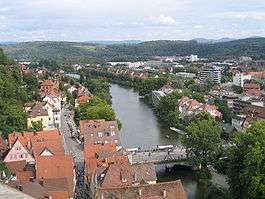

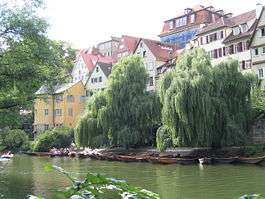
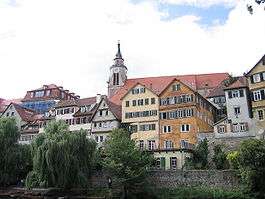
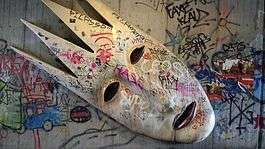
Tübingen's Altstadt (old town) survived the Second World War due to the city's lack of heavy industry. The result is a growing domestic tourism business. as visitors come to wander through one of the few completely intact historic Altstädte in Germany. The highlights of Tübingen include its crooked cobblestone lanes, narrow-stair alleyways picking their way through the hilly terrain, streets lined with canals, and well-maintained traditional half-timbered houses.
Old town landmarks include the Rathaus (City Hall) on Marktplatz (Market Square) and the castle, Schloß Hohentübingen, now part of the University of Tübingen. The central landmark is the Stiftskirche (Collegiate Church). Along with the rest of the city, the Stiftskirche was one of the first to convert to Martin Luther's protestant church. As such, it maintains (and carefully defends) several "Roman Catholic" features, such as patron saints. Below the Rathaus is a quiet, residential street called the Judengasse, the former Jewish neighborhood of Tübingen until the town's Jews were expelled in 1477. On the street corner is a plaque commemorating the fate of Tübingen's Jews.
The centre of Tübingen is the site of weekly and seasonal events, including regular market days on the Holzmarkt by the Stiftskirche and the Marktplatz by the Rathaus, an outdoor cinema in winter and summer, festive autumn and Christmas markets and Europe's largest Afro-Brazilian festival.
Students and tourists also come to the Neckar River in the summer to visit beer gardens or go boating in Stocherkähne, the Tübingen equivalent of Oxford and Cambridge punts, only slimmer. A Stocherkahn carries up to 20 people. On the second Thursday of June, all Stocherkahn punts take part in a major race, the Stocherkahnrennen.
Bebenhausen Abbey lies in the village of Bebenhausen, a district of Tübingen. A subdivision of the pilgrimage route known as the Way of St. James starts here and runs through Tübingen.
Culture
Tübingen has a notable arts culture as well as nightlife. In addition to the full roster of official and unofficial university events that range from presentations by the university's official poet in residence to parties hosted by the student associations of each faculty, the town can boast of several choirs, theatre companies and nightclubs. Also, Tübingen's Kunsthalle (art exhibition hall), on the "Wanne", houses two or three exhibits of international note each year.
Events
There are several festivals and open air markets on a regular basis:
- January
- Arab Movie Festival Arabisches Filmfestival
- April
- Latin American Movie Festival CineLatino (usually in April or May)
- May
- Rock Festival Rock im Tunnel (usually in May or June)
- June
- Poled boat race (German: Stocherkahnrennen), second Thursday of June, 2pm, around the Neckar Island
- Ract!festival, an alternative open air festival for free with music performances and workshops
- Tübinger Wassermusik: concerts on Stocherkahn boats
- July
- Tübinger Sommerinsel festival: various restaurants serving special meals and associations offering activities on the Neckar Island
- September
- Umbrisch-Provenzalischer Markt, open air market for Italian and French products
- Tübinger Stadtlauf the town 10km race
- Retromotor oldtimer festival (usually second or third September weekend)
- October
- Jazz- und Klassiktage: jazz and classic music festival
- Kite festival Drachenfest on the hill Österberg (usually third Sunday in October)
- French movie festival Französische Filmtage
- November
- Terre de femmes movie festival FrauenWelten
- December
- Nikolauslauf half marathon outside Tübingen in the forest
- Die Feuerzangenbowle film and large amount of Feuerzangenbowle drink made in a public square
- chocolate festival chocolART
- Christmas market
Sport
Tigers Tübingen are the city's only professional sports team, playing basketball.
Notable residents
Notable Tübingen residents and scholars included the poets Friedrich Hölderlin, Eduard Mörike and Ludwig Uhland, the neurologist Alois Alzheimer from whom Alzheimer's disease takes its name, and Friedrich Miescher who was the first to discover nucleic acids. Wilhelm Schickard who was the main precursor to the mechanical calculator, was born in nearby Herrenberg. Georg Wilhelm Friedrich Hegel, Friedrich Schelling, David Friedrich Strauss, and Johannes Kepler studied in Tübingen at the Tübinger Stift, and Joseph Alois Ratzinger (Pope Benedict XVI) held a chair in dogmatic theology at the University. Hermann Hesse worked in Tübingen as a bookseller trainee from 1895 to 1899.
Tübingen also is the home of scholars of international renown such as the Idealist philosopher Immanuel Hermann von Fichte, the theologian Hans Küng, textual criticism pioneer F.C. Baur, jurisprudent Gerhard Anschütz, famous author Walter Jens, and developmental biologist Christiane Nüsslein-Volhard. Slovene refugee Protestant preacher Primož Trubar, who published the first two books in the Slovene language and is regarded as the key consolidator of the Slovene identity, lived in Tübingen and its suburb Derendingen and is buried there. Martin Luther's companion Philipp Melanchthon, called Praeceptor Germaniae (Teacher of Germany), studied here from 1512 to 1514.
Former President of Germany Horst Köhler is a Tübingen alumnus as well, as was former Chancellor of Germany Kurt Georg Kiesinger. Nobel laureate and humanitarian Albert Schweitzer published his PhD thesis in Tübingen in 1899.
Tübingen is also the hometown of former track and field athlete Dieter Baumann, winner of the 5000m at the 1992 Summer Olympics. In 1990, the award-winning Israeli human rights lawyer Felicia Langer accepted a teaching position in Tübingen and has resided there since then.
American soccer coach Sigi Schmid, who has won Major League Soccer championships with the Los Angeles Galaxy and Columbus Crew and was an assistant coach for the U.S. at the 1994 FIFA World Cup, was born in Tübingen and moved to Torrance, California as a child.

Sung Yuri, a South Korean top actress and the youngest member of the K-Pop girl group Fin.K.L., was born in Tübingen in 1981. Her father, Sung Chong Hyon, received his doctorate degree in theology from Tübingen University and is currently a professor of New Testament at the Presbyterian College and Theological Seminary in Seoul, South Korea.[6]
Greek singer Despina Vandi was born in Tübingen, although her family moved back to Greece when Vandi was six years old.
Districts
Tübingen is divided into 22 districts, a town core of twelve districts (population of about 51,000) and ten outer districts (suburbs) (population of about 31,000):
Core city districts:
- Französisches Viertel
- Österberg
- Schönblick/Winkelwiese
- Lustnau
- Südstadt
- Universität
- Waldhäuser Ost
- Wanne
- Weststadt
- Zentrum
Outer districts:
- Ammerbuch
- Bebenhausen
- Bühl
- Derendingen
- Hagelloch
- Hirschau
- Kilchberg
- Pfrondorf
- Unterjesingen
- Weilheim, Baden-Württemberg
Population
Population development
Since World War II, Tübingen's population has almost doubled from about 45,000 to the current 88,000, also due to the incorporation of formerly independent villages into the city in the 1970s.
Currently, Lord Mayor Boris Palmer (Green Party) has set the ambitious goal of increasing the population of Tübingen to reach 100,000 within the next years. To achieve this, the city is closing gaps between buildings within the city proper by allowing new houses there; this is also to counter the tendency of urban sprawl and land consumption that has been endangering the preservation of rural landscapes of Southern Germany.
Historical population
|
|
|
¹ census result
International relations
Tübingen is twinned with:
|
In November 2009 Tübingen's city council voted to enter into talks with the city of Moshi in Tanzania, with the aim of Moshi becoming Tübingen's eleventh twin city.[11]
For their commitment to their international partnership, the Council of Europe awarded the Europe Prize to Tübingen and Aix-en-Provence in 1965.[12] The city's dedication to a European understanding is also reflected in the naming of several streets and squares, including the large Europaplatz (Europe Square) outside the railway station.
Infrastructure
By plane: Tübingen is about 35 km (21.75 mi) from the Baden-Württemberg state airport (Landesflughafen Stuttgart, also called Stuttgart Airport).
By automobile: Tübingen is on the Bundesstraße 27 (a "federal road") that crosses through Baden-Württemberg, connecting the town with Würzburg, Heilbronn, Stuttgart and the Landesflughafen (Stuttgart Airport) to the north and Rottweil and Donaueschingen to the south.
By rail: Tübingen Hauptbahnhof is on the regional train line Neckar-Alb Railway-Bahn (Neckar-Alb-Bahn) from Stuttgart Hauptbahnhof via Esslingen and Reutlingen to Tübingen. The average time of travel to Stuttgart is 1:01 hrs., with some trains taking only 45 mins. Other regional lines are the Hohenzollerische Landesbahn, connecting the town with Hechingen and Sigmaringen (so-called Zollernalb Railway), Zollernalbbahn and connections to Herrenberg (Ammer Valley Railway, Ammertalbahn) and Horb (Upper Neckar Railway, Obere Neckarbahn). Since 2009, there is also a daily direct Intercity link to Mannheim, Cologne and Düsseldorf as well as to Berlin.
Local public transport: The town, due to its high student population, features an extensive public bus network with more than 20 lines connecting the city districts and places outside of Tübingen such as Ammerbuch, Gomaringen and Nagold. There are also several night bus lines in the early hours every day. A direct bus is available to Stuttgart Airport (via Leinfelden-Echterdingen) as well as to Böblingen and Reutlingen.
Higher education


The Eberhard Karls University of Tübingen dates from 1477, making it one of the oldest in Germany. The city is also host to several research institutes including the Max Planck Institute for Biological Cybernetics, Max Planck Institute for Developmental Biology, Max Planck Institute for Intelligent Systems, The Friedrich Miescher Laboratory of the MPG (and formerly the Max Planck Institute for Biology) and the Hertie-Institute for Clinical Brain Research. The university also maintains an excellent botanical garden, the Botanischer Garten der Universität Tübingen.
Schools
More than 10,000 children and young adults in Tübingen regularly attend school. There are 30 schools in the town, some of which consist of more than one type of school. Of these, 17 are primary schools while the others are for secondary education: four schools are of the lowest rank, Hauptschule, three of the middle rank, Realschule, and six are Gymnasien (grammar schools). There also are four vocational schools (Berufsschule) and three special needs schools.
Primary schools
- Freie Aktive Schule Tübingen
- Grundschule Innenstadt / Silcherschule
- Grundschule Weilheim
- Ludwig-Krapf-Schule
- Grundschule Hügelstraße
- Französische Schule
- Dorfackerschule Lustnau
- Grundschule Hirschau
- Grundschule Hechinger Eck
- Grundschule auf der Wanne
- Grundschule Aischbach
- Grundschule Winkelwiese / Waldhäuser Ost
- Grundschule Bühl
- Grundschule Bühl
- Grundschule Kilchberg
- Grundschule Hagelloch
- Grundschule Pfrondorf
- Grundschule Unterjesingen
Hauptschulen
- Dorfackerschule Lustnau
- Mörikeschule
- Geschwister-Scholl-Schule
- Hauptschule Innenstadt
Realschulen
- Walter-Erbe-Realschule
- Albert-Schweitzer-Realschule
- Geschwister-Scholl-Schule
Gymnasien
- Carlo-Schmid-Gymnasium
- Geschwister-Scholl-Schule
- Kepler-Gymnasium
- Uhland-Gymnasium
- Wildermuth-Gymnasium
- Freie Waldorfschule
Vocational schools (Berufsschulen)
- Gewerbliche Schule
- Wilhelm-Schickard-Schule
- Mathilde-Weber-Schule
- Bildungs- und Technologiezentrum
Gallery

 Houses in the snow
Houses in the snow Hölderlinturm
Hölderlinturm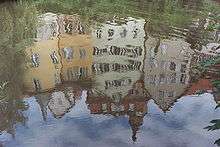 Reflection of houses in the Neckar
Reflection of houses in the Neckar Fountain in front of the Rathaus
Fountain in front of the Rathaus Fountain in front of St-Georg Stiftskirche
Fountain in front of St-Georg Stiftskirche St Georg Stiftskirche in snow
St Georg Stiftskirche in snow St Georg Stiftskirche in winter
St Georg Stiftskirche in winter Carving at entry to Schloß
Carving at entry to Schloß.jpg) Statues
Statues St. George being broken on the wheel, St. Georg Stiftskirche
St. George being broken on the wheel, St. Georg Stiftskirche.jpg) Graffiti art, Epplehaus [13] (2018)
Graffiti art, Epplehaus [13] (2018)
References
- Notes
- "Bevölkerung nach Nationalität und Geschlecht am 31. Dezember 2018". Statistisches Landesamt Baden-Württemberg (in German). July 2019.
- On student statistics, see here.
- "Tübingen", Wikipedia (in German), 2020-02-21, retrieved 2020-02-26
- "Tübingen", Wikipedia (in German), 2020-02-21, retrieved 2020-02-26
- "Tübingen", Wikipedia (in German), 2020-02-21, retrieved 2020-02-26
- Faculty List of the Presbyterian College and Theological Seminary current as of March 3, 2012
- Association of twinnings and international relations of Aix-en-Provence
- Mairie of Aix-en-Provence - Twinnings and partnerships Archived 2009-01-13 at the Wayback Machine
- "Association Suisse des Communes et Régions d'Europe". L'Association suisse pour le Conseil des Communes et Régions d'Europe (ASCCRE) (in French). Archived from the original on 2012-07-24. Retrieved 2013-07-20.
- Perugia Official site - Relazioni Internazionali Archived 2012-02-15 at the Wayback Machine(in Italian)
- Kaiser, Ute (17 November 2009). "Tansanische Stadt auserwählt. Tübinger Rat ist für Partnerschaft mit Moshi" [Tanzanian town chosen. Tübingen city council in favour of partnership with Moshi.]. Schwäbisches Tagblatt (in German). Tübingen. Archived from the original on 17 July 2011. Retrieved 14 December 2009.
- "Sister Cities". Universitätsstadt Tübingen. Archived from the original on 17 April 2009.
- See German Wikipedia: Epplehaus
External links
| Wikimedia Commons has media related to Tübingen. |
| Wikivoyage has a travel guide for Tübingen. |
- Official website

- Tübingen at Curlie
- Eberhard Karls University (in German and English)
- Tourism information (in German)
- Tübingen page of German National Tourist Board (in English)
- Tübingen Insider Tipps (in German)
- Tuebingen, city of culture (in English)
- War and Holocaust memorials in and around Tübingen at the Sites of Memory webpage
- City Memorial Projects (Jewish and post-war history) website (in German)
- Tourism Information for Tübingen and the river Neckar (in German)
- The Neckar river and its punts, called "Stocherkahn". Detailed information about the traditional leisure attraction in Tübingen" (in German)
- Tübingen Stocherkahn Manufacturers (in German)
- Student union of Tübingen - registered society - housing for students (in German)
- Panorama 360 degree of Tuebingen (in German)
- Martin Biastoch: Tübinger Studenten im Kaiserreich. Eine sozialgeschichtliche Untersuchung, Sigmaringen 1996 (Contubernium — Tübinger Beiträge zur Universitäts- und Wissenschaftsgeschichte Bd. 44) ISBN 3-515-08022-8